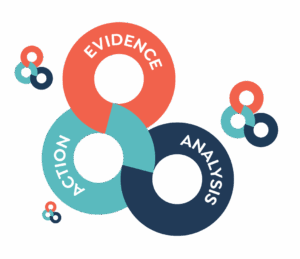Why Bright Spots Matter
This protocol is personal. Too many times I heard people name what my own sons couldn’t do—while their quiet victories went unseen. Years earlier, as the art director at a live‑in summer camp in Michigan for children with speech and hearing impairments—part of Central Michigan University’s Summer Specialty Clinics in Mt. Pleasant—I learned a different lesson: breakthroughs arrive in moments. A new sound formed. A hand found rhythm with paint. A child connected. When we studied those moments, more moments came, hope multiplied, and direction returned.
That experience shaped my practice. In PLCs, we don’t just fix what’s broken—we amplify what’s working so more students can feel it.
Standing on the Field’s Shoulders
 This protocol builds on what the field already knows:
This protocol builds on what the field already knows:
- Success Analysis Protocols (NSRF) that examine effective practice.
- Positive Deviance (Pascale, Sternin, & Sternin, 2010), which identifies solutions among those who succeed against the odds.
- Appreciative Inquiry (Cooperrider & Whitney, 2005), which asks what gives life when we’re at our best.
- Improvement Science (Bryk, Gomez, Grunow, & LeMahieu, 2015) that learns from variation, including positive outliers.
We weave these traditions into the EAA cycle—Evidence → Analysis → Action (Bloomberg & Pitchford, 2023)—and pair them with AI to move faster without losing humanity.
Science
- Learn from variation. Sustainable improvement comes from studying positive outliers to understand conditions for success (Bryk et al., 2015).
- Strengths spark energy. Asking “what works” fuels morale and innovation (Cooperrider & Whitney, 2005).
- Solutions exist inside the system. Positive deviance shows how to surface and spread them (Pascale et al., 2010).
- Bright spots build efficacy. Naming and sharing success strengthens collective teacher efficacy and balances deficit narratives (Heath & Heath, 2010).
- EAA makes it actionable. Evidence → Analysis → Action keeps the learning disciplined and repeatable (Bloomberg & Pitchford, 2023).
The Bright Spot Protocol (EAA in Action)
 The Bright Spot Protocol is simple but powerful: gather moments of success, make meaning from them, scale what works, and celebrate the shift. Here’s how it runs in four clear steps:
The Bright Spot Protocol is simple but powerful: gather moments of success, make meaning from them, scale what works, and celebrate the shift. Here’s how it runs in four clear steps:
Step 1 — Evidence (Gather)
Bring 1–2 de‑identified (names and other identifiers removed) bright spots: a piece of student work, a moment of agency, a surprising leap.
Step 2 — Analysis (Make Meaning)
Ask together:
- What student moves made this possible?
- What teacher moves/conditions enabled it?
- What identity, cultural, or contextual strengths were present? Then invite AI (after your human pass) to cluster themes, connect research, and surface design principles.
Step 3 — Action (Scale What Works)
Co‑design how to replicate conditions so more students can access them. Draft strategies, scaffolds, and extensions. Use AI to generate multilingual supports, exemplars, or “starter kits,” then refine through teacher judgment.
Step 4 — Reflection (Celebrate & Commit)
Name what shifted in your understanding. Choose one concrete move to test before the next cycle. Celebrate publicly: let students see what “good” looks and feels like.
Framing Through the 4 PLC Questions
Bright spots don’t just inspire—they answer the core PLC questions. By studying what’s working, we make success visible, use it as evidence of learning, reverse-engineer it for students who need support, and extend it for those ready to soar.
- What do we want students to learn?
Bright spots make success visible and concrete.
- How will we know if they’ve learned it?
Bright spots are evidence—not anecdotes—of deep understanding and transfer.
- How will we respond when students don’t learn it?
Reverse‑engineer bright spots to design equitable entry points and scaffolds.
- How will we respond when students already know it?
Use bright spots to craft extensions and leadership roles for advanced learners.
Using AI Thoughtfully in PLCs
AI brings efficiency—pattern finding, idea generation, and translation—so we have more time for TAP: Teacher Analysis and Professional Dialogue. We honor creativity and personalization by debating AI output, adapting it for our students, and deciding what belongs in our classrooms. That dialogue is how we build professional capital.
AI Prompt (Copy & Paste)
AI Assistant Prompt — Bright Spot Protocol
“I will share 1–2 de‑identified bright spots (examples of student success or unexpected achievement). For each bright spot:
-
-
-
- Identify patterns or conditions that contributed to the success.
- Suggest research‑aligned hypotheses for why it worked.
- Generate ways to replicate/adapt these conditions so more students benefit.
- Offer equity scaffolds and multilingual supports to expand access.
- Propose extension challenges for students who have already demonstrated success.”
-
-
Peer Facilitation Prompts (for PLC Leads)
- “Share a bright spot. What exactly happened?”
- “Which student and teacher moves mattered most?”
- “What conditions—time, task, talk, tools—were present?”
- “What themes does AI surface? What do we accept, adapt, or reject?”
- “What one move will we test, and how will we know it worked?”
Why This Matters
Where the Mistake Protocol (read the blog post) turns errors into learning fuel, the Bright Spot Protocol scales what already works. Together, they change the emotional weather of a school—from scarcity to possibility. More students feel seen. More teachers feel the lift of collective efficacy. Hope gets practical.
- Bring an AI-PLC Lab to your school. One day. Four protocols. Real evidence, real analysis, real action. See how mistakes and bright spots can power learning—and leave with tools your teachers can use tomorrow.
References
- Bloomberg, P. J., & Wells, I. (2025, forthcoming). AI-Powered PLC Protocols. Mimi & Todd Press.
- Bloomberg, P. J., & Pitchford, B. (2023). Leading Impact Teams: Building a Culture of Efficacy and Agency (2nd ed.). Mimi & Todd Press.
- Bryk, A. S., Gomez, L. M., Grunow, A., & LeMahieu, P. G. (2015). Learning to Improve: How America’s Schools Can Get Better at Getting Better. Harvard Education Press.
- Cooperrider, D. L., & Whitney, D. (2005). Appreciative Inquiry: A Positive Revolution in Change. Berrett‑Koehler.
- Heath, C., & Heath, D. (2010). Switch: How to Change Things When Change Is Hard. Broadway Books.
- Pascale, R., Sternin, J., & Sternin, M. (2010). The Power of Positive Deviance: How Unlikely Innovators Solve the World’s Toughest Problems. Harvard Business Press.



